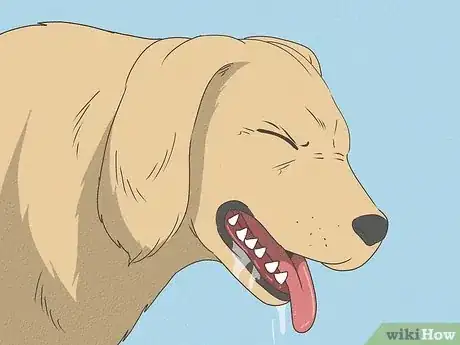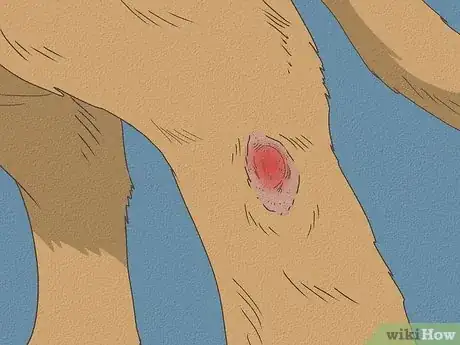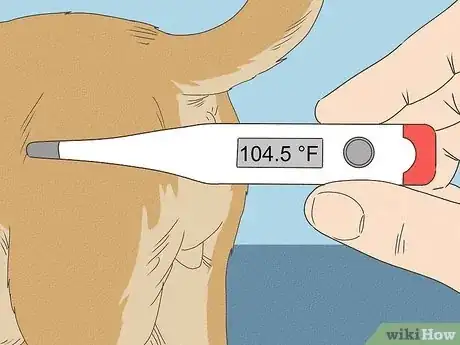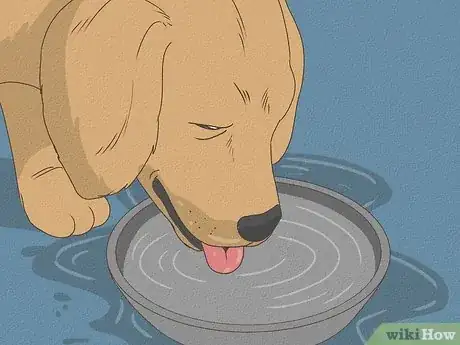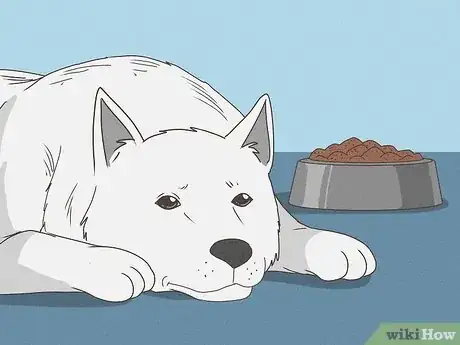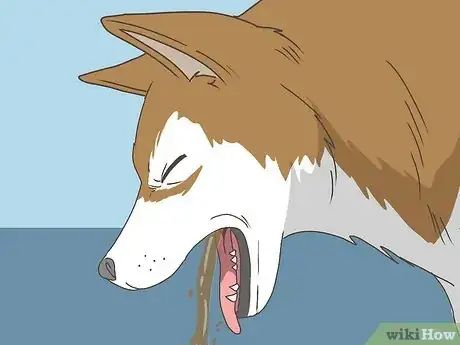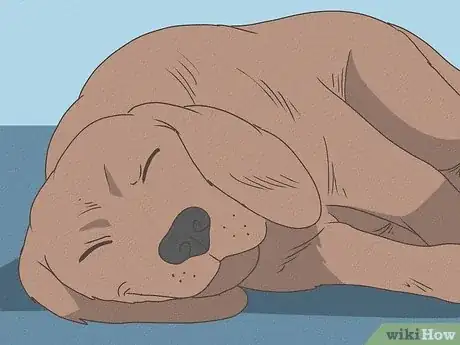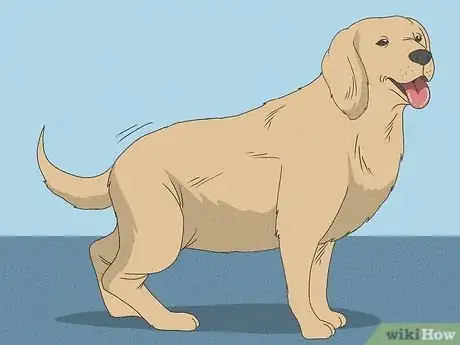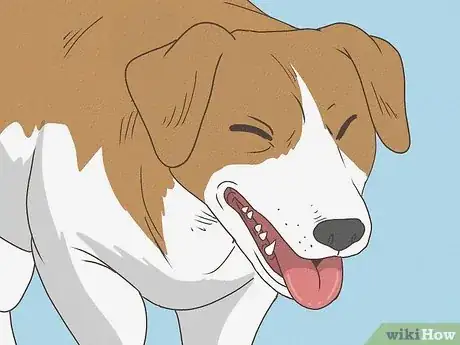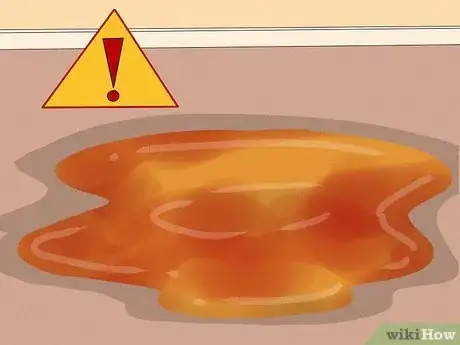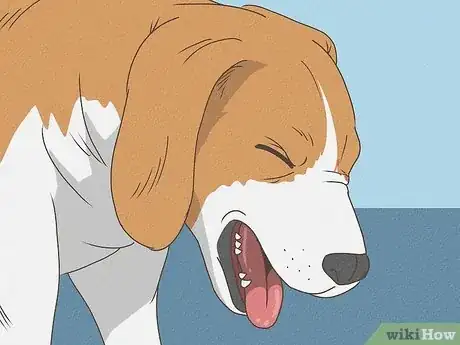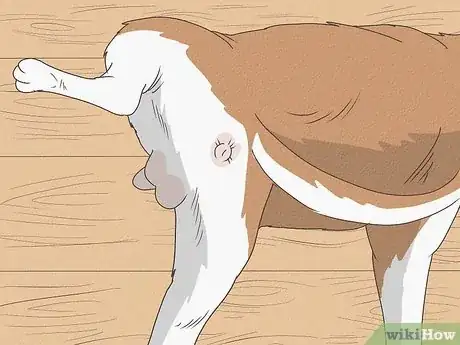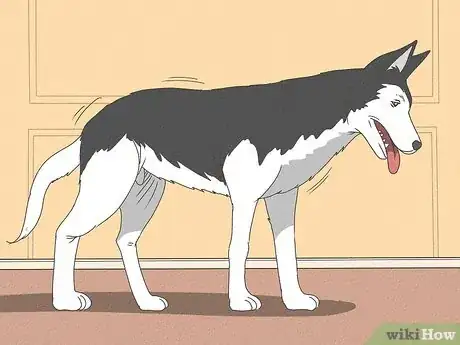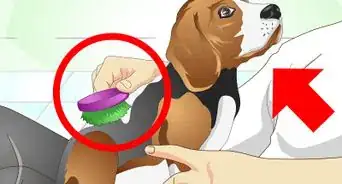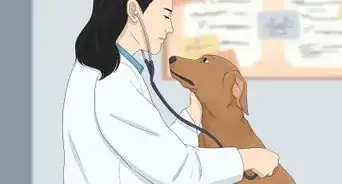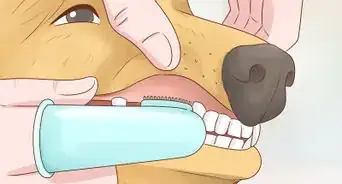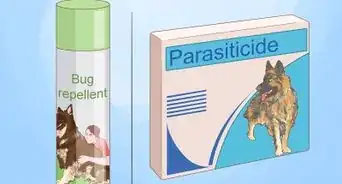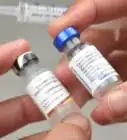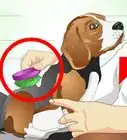This article was co-authored by Ray Spragley, DVM. Dr. Ray Spragley is a Doctor of Veterinary Medicine and the Owner/Founder of Zen Dog Veterinary Care PLLC in New York. With experience in multiple institutions and private practices, Dr. Spragley’s specializations and interests include non-surgical management of cranial cruciate ligament tears, Intervertebral Disk Disease(IVDD), and pain management in osteoarthritis. Dr. Spragley holds a BS in Biology from SUNY Albany and has a Doctor of Veterinary Medicine degree (DVM) from Ross University School of Veterinary Medicine. He is also a Certified Canine Rehabilitation Therapist (CCRT) through the Canine Rehab Institute as well as a Certified Veterinary Acupuncturist (CVA) through Chi University.
There are 10 references cited in this article, which can be found at the bottom of the page.
wikiHow marks an article as reader-approved once it receives enough positive feedback. In this case, several readers have written to tell us that this article was helpful to them, earning it our reader-approved status.
This article has been viewed 598,512 times.
Just like their owners, dogs can become ill with anything from a minor virus to something more dangerous with serious complications. Since your pet cannot tell you what’s wrong, you should keep an eye out for certain symptoms. Always consult with your veterinarian if you ever suspect your dog may be ill.
Steps
Evaluating Your Dog’s Appearance
-
1Watch for excessive drooling or bad breath[1] . Excessive drooling or bad breath can be signs that your dog might need some teeth extracted. In order to prevent many dental problems, try to train your dog so that it allows you to brush their teeth. Look for the following symptoms in your dog that might indicate a dental problem:
- Watch to see if your dog is eating less.
- Notice if your dog is sensitive to you touching their muzzle.
- You may also visibly notice your dog having trouble chewing.[2]
-
2Listen for excessive coughing or honking. If your dog is coughing, it might not be a reason to worry. However, coughing that lasts for any longer than a twenty-four hour period might be something more serious. Get any severe coughing in your dog checked out by your veterinarian.[3]Advertisement
-
3Pay attention to changes in your dog's behavior. Just as humans may act differently when they don’t feel well, you may notice changes in your dog's behavior if it’s not feeling well.[6]
- Changes may include, but are not limited to, increase or decrease in appetite or thirst, hyperactivity, whining or noticeably lowered energy levels.
- If you notice changes in your dog's behavior, visit your veterinarian.
- If the irritation seems to relate to petting a specific spot, take note, it may be where your dog is injured or sick.[7]
-
4Keep a close eye on any sores or lumps. Dogs can develop ingrown hairs, cysts, and other skin blemishes, so not every small lump or bump is an immediate cause for concern.[8] However, the following symptoms should be seen by a professional.[9]
- Lumps growing in size.[10]
- Lumps becoming deeply attached to tissues.
- Oozing or bleeding sores.
-
5Take your dog’s temperature. Canines can run fevers just like humans can. If your dog has a fever, especially in conjunction with other symptoms, visit your vet as soon as you are able.[11]
- A temperature of 103 °F (39 °C) is high. Take your dog to the vet as soon as possible.
- A temperature of 104.5 °F (40.3 °C) requires immediate medical attention.[12]
Evaluating Your Dog’s Diet
-
1Watch for excessive drinking. Monitor the amount of water your dog drinks daily. If you notice any big changes in this amount, take note. Drinking too much or too little can indicate a problem that requires veterinary attention.[13]
- Rule out everyday reasons such as strenuous play or a hot day.
- If you notice your dog drinking much more than normal for a consecutive week, see your vet.
-
2Track your dog’s appetite. Changes in appetite, especially those that lead to weight loss or gain, can indicate illness.[14] [15] Unexpected weight loss or gain should always be met with a trip to the vet.
- In the short term, loss of appetite for your dog can be a sign of fever, pain, or stress, as well as many other possible reasons.
- If the loss of appetite is combined with any other noticeable symptoms, you should see a vet immediately.[16]
-
3
Evaluating Your Dog’s Activity Level
-
1Examine your pet’s energy levels.[21] Prolonged lethargy is a strong sign that your pooch isn’t feeling well.[22] While you don’t need to worry about a tired dog after active play, keep an eye out for other signs such as decreased exercise tolerance or general weakness combined with the lethargy.[23]
- Unusually low energy levels, over two or three days should be checked with a vet.
- Lethargy, in combination with other symptoms, also requires the attention of your vet.[24]
- Extremely high levels of energy can also be a problem that needs medical attention.
-
2Pay attention to scratching. All dogs scratch fairly regularly. However, excessive scratching can be a sign of a health problem. If the scratching is excessive, don't ignore it. Look for these possible causes or ask your veterinarian more about them:
- Scratching is a typical sign of fleas, ticks, or mange mites.[25]
- Scratching can also mean endocrine or hormonal problems in your dog.[26]
- Dogs can also suffer from allergies just like humans, which can lead to itching.
- Take your dog to the vet.
- Most vets will examine the animal, try to reach a diagnosis or suggest tests to reach a diagnosis.
- After testing, your vet can prescribe a course of treatment to correct the underlying problem or at least make the dog more comfortable.
-
3Look for difficulty rising or mobility issues. If your dog starts showing signs of stiffness, manifested through difficulty getting up or climbing stairs, then you should have your pet examined. [27]
- This symptom can be a result of anything from hip dysplasia to arthritis to Lyme disease from tick-borne bacteria.
- The earlier Lyme disease is treated, the better the prognosis, so see a vet quickly if you notice this symptom, especially in younger dogs.
-
4Watch for labored breathing. Labored breathing can indicate a problem with your dog's respiratory system. Identifying the cause can be difficult by yourself. Bring your dog to a vet to accurately diagnose any problems with your dog's breathing.[28]
- Labored breathing requires urgent attention.
- If your dog's gums have a bluish tint, seek immediate care.
-
5Keep track of accidents. House-trained pets rarely start having accidents unless there is a problem. If your dog inexplicably begins having indoor accidents, then your vet will likely want to schedule some tests to find out the problem.[29]
- Having accidents for a few days in a row is a good indication of a problem.
-
6Watch for major changes in urination. Changes in the frequency of your dog's urination can be an indication of a problem. Check also for any blood or strange discolorations in your dog's urine.[30] If you find anything unusual about your dog's urine or urination habits, contact your veterinarian.[31]
- Either an increase or decrease in urination can be an indication of an illness.
- Problems with urination will may involve the kidneys or bladder stones.
Knowing When to Seek Emergency Care
-
1Watch for non-productive retching. If your dog is trying to vomit, and cannot, this can be associated with the life-threatening condition, bloat. Get your dog to the vet immediately in order to ensure the best outcome.[32]
-
2Monitor for non-productive urination. If your dog is trying to urinate, but is unable to do so, take it to the veterinarian quickly. Inability to urinate indicates some form of blockage and can be quite serious.[33]
-
3Look for any weakness. If your dog is having trouble standing, is swaying, or has collapsed then you must seek care quickly. Even if your dog is tired, it will be able to stand and move. Collapsing is a definite sign that your dog needs medical attention. [34]
Expert Q&A
-
QuestionCan I remove skin tags from my dog?
 Ray Spragley, DVMDr. Ray Spragley is a Doctor of Veterinary Medicine and the Owner/Founder of Zen Dog Veterinary Care PLLC in New York. With experience in multiple institutions and private practices, Dr. Spragley’s specializations and interests include non-surgical management of cranial cruciate ligament tears, Intervertebral Disk Disease(IVDD), and pain management in osteoarthritis. Dr. Spragley holds a BS in Biology from SUNY Albany and has a Doctor of Veterinary Medicine degree (DVM) from Ross University School of Veterinary Medicine. He is also a Certified Canine Rehabilitation Therapist (CCRT) through the Canine Rehab Institute as well as a Certified Veterinary Acupuncturist (CVA) through Chi University.
Ray Spragley, DVMDr. Ray Spragley is a Doctor of Veterinary Medicine and the Owner/Founder of Zen Dog Veterinary Care PLLC in New York. With experience in multiple institutions and private practices, Dr. Spragley’s specializations and interests include non-surgical management of cranial cruciate ligament tears, Intervertebral Disk Disease(IVDD), and pain management in osteoarthritis. Dr. Spragley holds a BS in Biology from SUNY Albany and has a Doctor of Veterinary Medicine degree (DVM) from Ross University School of Veterinary Medicine. He is also a Certified Canine Rehabilitation Therapist (CCRT) through the Canine Rehab Institute as well as a Certified Veterinary Acupuncturist (CVA) through Chi University.
Veterinarian Skin tags should not be removed at home. What appears to be a skin tag could actually be a cancerous lesion. In addition, there is a high likelihood that complications can occur such as excessive bleeding after removal and infection at the area of removal. Your veterinarian can identify if this is just a skin tag and remove it using a scalpel and may place sutures to close the skin. If they are worried that it may be a cancerous lesion it may be sent out for a biopsy.
Skin tags should not be removed at home. What appears to be a skin tag could actually be a cancerous lesion. In addition, there is a high likelihood that complications can occur such as excessive bleeding after removal and infection at the area of removal. Your veterinarian can identify if this is just a skin tag and remove it using a scalpel and may place sutures to close the skin. If they are worried that it may be a cancerous lesion it may be sent out for a biopsy. -
QuestionCan the vet help with kennel cough?
 Ray Spragley, DVMDr. Ray Spragley is a Doctor of Veterinary Medicine and the Owner/Founder of Zen Dog Veterinary Care PLLC in New York. With experience in multiple institutions and private practices, Dr. Spragley’s specializations and interests include non-surgical management of cranial cruciate ligament tears, Intervertebral Disk Disease(IVDD), and pain management in osteoarthritis. Dr. Spragley holds a BS in Biology from SUNY Albany and has a Doctor of Veterinary Medicine degree (DVM) from Ross University School of Veterinary Medicine. He is also a Certified Canine Rehabilitation Therapist (CCRT) through the Canine Rehab Institute as well as a Certified Veterinary Acupuncturist (CVA) through Chi University.
Ray Spragley, DVMDr. Ray Spragley is a Doctor of Veterinary Medicine and the Owner/Founder of Zen Dog Veterinary Care PLLC in New York. With experience in multiple institutions and private practices, Dr. Spragley’s specializations and interests include non-surgical management of cranial cruciate ligament tears, Intervertebral Disk Disease(IVDD), and pain management in osteoarthritis. Dr. Spragley holds a BS in Biology from SUNY Albany and has a Doctor of Veterinary Medicine degree (DVM) from Ross University School of Veterinary Medicine. He is also a Certified Canine Rehabilitation Therapist (CCRT) through the Canine Rehab Institute as well as a Certified Veterinary Acupuncturist (CVA) through Chi University.
Veterinarian Kennel cough will typically resolve without treatment in a healthy dog. To minimize symptoms while infected, make the dog more comfortable, and prevent the infection from progressing to pneumonia your veterinarian may prescribe an antibiotic such as doxycycline for a week. Vaccines are also available to protect against kennel cough. The vaccines target the bacteria Bordatella minimizing the chance of your dog being infected with kennel cough although it does not provide full immunity from kennel cough because kennel cough can develop from a few other bacterias and viruses.
Kennel cough will typically resolve without treatment in a healthy dog. To minimize symptoms while infected, make the dog more comfortable, and prevent the infection from progressing to pneumonia your veterinarian may prescribe an antibiotic such as doxycycline for a week. Vaccines are also available to protect against kennel cough. The vaccines target the bacteria Bordatella minimizing the chance of your dog being infected with kennel cough although it does not provide full immunity from kennel cough because kennel cough can develop from a few other bacterias and viruses. -
QuestionWhen should I be concerned about my dog vomiting?
 Ray Spragley, DVMDr. Ray Spragley is a Doctor of Veterinary Medicine and the Owner/Founder of Zen Dog Veterinary Care PLLC in New York. With experience in multiple institutions and private practices, Dr. Spragley’s specializations and interests include non-surgical management of cranial cruciate ligament tears, Intervertebral Disk Disease(IVDD), and pain management in osteoarthritis. Dr. Spragley holds a BS in Biology from SUNY Albany and has a Doctor of Veterinary Medicine degree (DVM) from Ross University School of Veterinary Medicine. He is also a Certified Canine Rehabilitation Therapist (CCRT) through the Canine Rehab Institute as well as a Certified Veterinary Acupuncturist (CVA) through Chi University.
Ray Spragley, DVMDr. Ray Spragley is a Doctor of Veterinary Medicine and the Owner/Founder of Zen Dog Veterinary Care PLLC in New York. With experience in multiple institutions and private practices, Dr. Spragley’s specializations and interests include non-surgical management of cranial cruciate ligament tears, Intervertebral Disk Disease(IVDD), and pain management in osteoarthritis. Dr. Spragley holds a BS in Biology from SUNY Albany and has a Doctor of Veterinary Medicine degree (DVM) from Ross University School of Veterinary Medicine. He is also a Certified Canine Rehabilitation Therapist (CCRT) through the Canine Rehab Institute as well as a Certified Veterinary Acupuncturist (CVA) through Chi University.
Veterinarian Occasional vomiting can be normal. When it is time for your dog to eat again, feed only half of a normal meal and see if they hold it down. If there are multiple bouts of vomiting, blood in vomit, straining to defecate, or personality changes (listless or uncomfortable) you should call your veterinarian to schedule an appointment immediately. This can be signs of gastroenteritis, foreign material ingestion, or pancreatitis.
Occasional vomiting can be normal. When it is time for your dog to eat again, feed only half of a normal meal and see if they hold it down. If there are multiple bouts of vomiting, blood in vomit, straining to defecate, or personality changes (listless or uncomfortable) you should call your veterinarian to schedule an appointment immediately. This can be signs of gastroenteritis, foreign material ingestion, or pancreatitis.
References
- ↑ The Five minute Veterinary Consult. Smith and Tilley. Publishers: Wiley-Blackwell
- ↑ http://www.doghealth.com/how-to/how-to-tell-if-your-dog-is-sick
- ↑ Ray Spragley, DVM. Veterinarian. Expert Interview. 5 March 2021.
- ↑ http://www.doghealth.com/how-to/how-to-tell-if-your-dog-is-sick
- ↑ http://pets.webmd.com/features/pet-symptoms-6-signs-illness-dog-cat?page=4
- ↑ http://www.doghealth.com/how-to/how-to-tell-if-your-dog-is-sick
- ↑ http://www.doghealth.com/how-to/how-to-tell-if-your-dog-is-sick
- ↑ Ray Spragley, DVM. Veterinarian. Expert Interview. 5 March 2021.
- ↑ http://www.doghealth.com/how-to/how-to-tell-if-your-dog-is-sick
- ↑ Small animal internal medicine. Nelson and Couto. Publishers: Mosby
- ↑ http://www.doghealth.com/how-to/how-to-tell-if-your-dog-is-sick
- ↑ http://www.doghealth.com/how-to/how-to-tell-if-your-dog-is-sick
- ↑ The Five minute Veterinary Consult. Smith and Tilley. Publishers: Wiley-Blackwell
- ↑ http://www.pethealthnetwork.com/dog-health/dog-checkups-preventive-care/top-10-signs-your-dog-may-be-sick-and-what-you-can-do-about
- ↑ The Five minute Veterinary Consult. Smith and Tilley. Publishers: Wiley-Blackwell
- ↑ http://pets.webmd.com/features/pet-symptoms-6-signs-illness-dog-cat?page=2
- ↑ http://www.pethealthnetwork.com/dog-health/dog-checkups-preventive-care/top-10-signs-your-dog-may-be-sick-and-what-you-can-do-about
- ↑ Ray Spragley, DVM. Veterinarian. Expert Interview. 5 March 2021.
- ↑ http://www.doghealth.com/how-to/how-to-tell-if-your-dog-is-sick
- ↑ http://pets.webmd.com/features/pet-symptoms-6-signs-illness-dog-cat?page=2
- ↑ The Five minute Veterinary Consult. Smith and Tilley. Publishers: Wiley-Blackwell
- ↑ http://www.doghealth.com/how-to/how-to-tell-if-your-dog-is-sick
- ↑ http://pets.webmd.com/features/pet-symptoms-6-signs-illness-dog-cat?page=3
- ↑ http://pets.webmd.com/dogs/my-dog-weak-lethargic
- ↑ http://pets.webmd.com/features/pet-symptoms-6-signs-illness-dog-cat?page=4
- ↑ http://pets.webmd.com/features/pet-symptoms-6-signs-illness-dog-cat?page=4
- ↑ http://pets.webmd.com/features/pet-symptoms-6-signs-illness-dog-cat?page=4
- ↑ http://www.doghealth.com/how-to/how-to-tell-if-your-dog-is-sick
- ↑ http://www.doghealth.com/how-to/how-to-tell-if-your-dog-is-sick
- ↑ Small animal internal medicine. Nelson and Couto. Publishers: Mosby
- ↑ http://pets.webmd.com/features/pet-symptoms-6-signs-illness-dog-cat?page=3
- ↑ Ray Spragley, DVM. Veterinarian. Expert Interview. 5 March 2021.
- ↑ The Five minute Veterinary Consult. Smith and Tilley. Publishers: Wiley-Blackwell
- ↑ The Five minute Veterinary Consult. Smith and Tilley. Publishers: Wiley-Blackwell
About This Article
If you're worried your dog might be sick but you're not sure, there are some common signs you can watch out for. Excessive coughing, honking, or labored breathing can be signs of a respiratory issue or a problem with its immune system. Your dog may be sick if it has a decreased appetite or lack of energy for more than a couple of days. On the other hand, if your dog has an increased appetite or it’s drinking excessive amounts of water when it’s not hot outside, this could also be a sign of illness. If your dog is scratching excessively, it’s possible that it has fleas, ticks, or some kind of infection. If you think your dog is sick, take it to the vet so they can help you figure out what's going on and get your furry friend feeling happy and healthy again. For more tips from our Veterinary co-author, including how to spot potential dental issues in your dog, read on.
